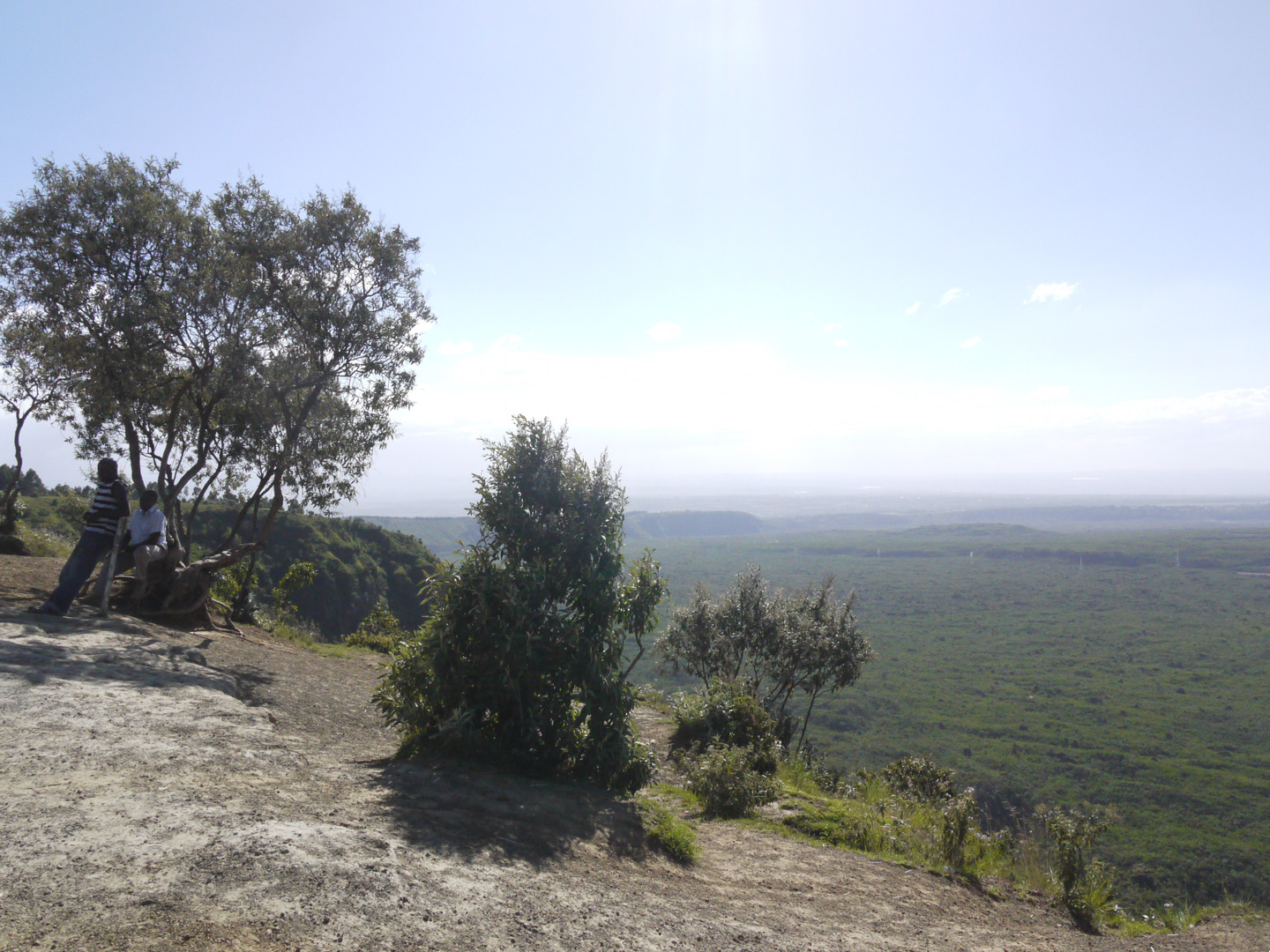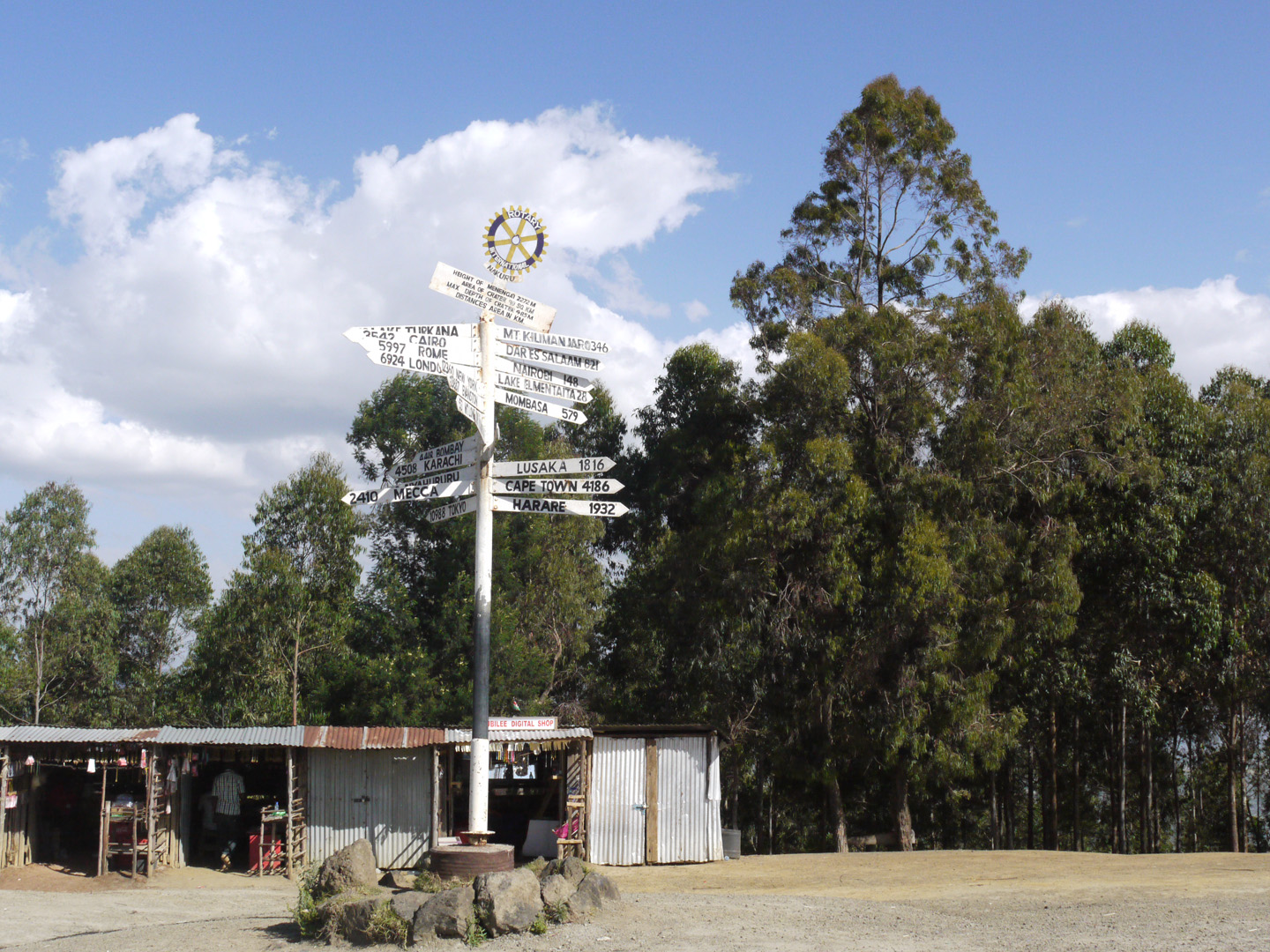Philip was assigned as our guide. Vital stats given : Kikuyu, 36 years old, three children – two girls one boy of 10 years – ‘he is going to be a doctor, it’s good for a family to have a doctor.’ The girls? No particular ambition. ‘Does he want to do this?’ “He’s a good boy.”
No comment.
We load Philip the guide into the car and drive up the Menengai Crater, actually a shield caldera built up by fluid magma basalt flows. This gives it a flattened undramatic shape, not the classic steep volcano shape. It last erupted a million years ago, but the caldera was formed 2,000,000 years ago. Vital stats for the caldera: 90 square km circumference, 485m to caldera floor, four fumeroles with a measured temperature of 94o C, about 70 lava flows on the ridged caldera floor. It’s one of the best preserved calderas in the world – not that the guide had this information, this comes from John Seach, volcanologist, on the ‘net.
 The guide took us round the rim away from the carpark and showed us the densely farmed area just out of the caldera. These shambas (African family smallholdings) (he said) were white settler land given as compensation by former Mau Mau fighters to the end of fighting: “Imagine if someone came to your house and stole it from you, would you not fight to get it back?” A reasonable point of view – except the land was originally Maasai land. The white settlers took it, paying the British colonial government for the land under the soldier settlement scheme lottery.
The guide took us round the rim away from the carpark and showed us the densely farmed area just out of the caldera. These shambas (African family smallholdings) (he said) were white settler land given as compensation by former Mau Mau fighters to the end of fighting: “Imagine if someone came to your house and stole it from you, would you not fight to get it back?” A reasonable point of view – except the land was originally Maasai land. The white settlers took it, paying the British colonial government for the land under the soldier settlement scheme lottery.
According to a long time Kenyan settler whose grandfather bought land in the Cherangani Hills north of Kitale, the Maasai were moved out, causing great deprivation, into the Mau Highlands. When the farms were nationalised, after independence in 1963, the Maasai would not buy back their land and farms, their tradition is pastoral with cattle not farms. The Kikuyu though did have the money and did buy. It is now Kikuyu land.
While it is not true that the British paid compensation, or this particular land had been Kikuyu before the white settlers, it is true that the Kikuyu, a people of about one million, had become economically disadvantaged during the colonial times. The guide believed it and maybe it has become the new truth.
Researching on the ‘net, consensus appears to be that Nakuru was at the heart of the Mau Mau struggle – both an independence movement and a civil war.. The fighters met in a large cave – said to hold 2000 people – on the eastern side of the Crater. This was a brutal battle in which the Mau fighters murdered hundreds of white settlers and thousands of Kikuyu. The British response was equally barbaric with Mau fighters held in inhumane concentration camps. Neither side held the moral high ground. Today the caves have been cleansed with a new name, The Sacred Caves, and is a popular church.
The guide then told us that the guiding fee was just for the information at the rim (and did we want to buy from the tourist kiosks at a better price?) and the walk down was extra! Since he had already told us that normally he would be expected to walk up with tourists, this as a bit of a cheek from a less than impressive guide. We said that we didn’t need him to walk down with us, we would go alone and he said he might as well come with us. It was not a good start to the walk.
…..
The caldera has much degraded secondary forest of predominantly eucalyptus, bushes and scrub grow up to its rounded top. Apart from a view of the caldera itself, the only other noteworthy thing was a huge signpost giving distances to London, New York, Cairo and many others.
 The road goes to the southern rim ending with desultory kiosks selling small things and drinks and a half-built Eco-Lodge and bar. A Danish environmental company planted eucalyptus in collaboration with the National Park. It’s surprising that native trees weren’t planted but presumably they had valid reasons. At first sight, the area was disappointing.
The road goes to the southern rim ending with desultory kiosks selling small things and drinks and a half-built Eco-Lodge and bar. A Danish environmental company planted eucalyptus in collaboration with the National Park. It’s surprising that native trees weren’t planted but presumably they had valid reasons. At first sight, the area was disappointing.
Nor was the view what I was expecting although it was big and deep. No one lives in the crater, but an electricity company is drilling 3km into the thermal vents to use the volcanic heat to generate steam for electricity. There were about five drilling platforms there so far and platforms for many more. A small aircraft pilot we met in Kitale said that he has noticed an increase in sulphur in the air when flying over the crater since the holes were drilled.
According to Wikipedia, Menengai is two words – ‘Mene’ being ‘corpse’ in the Maa language, and ‘Ngai’ being ‘God’ in Kikuyu. One Maasai legend is that the steam rising from the crater floor are the souls of dead Maasai. The useless Philip said that the Maasai had ‘fought each other to the death or had had accidents or died of negligence’. His version of the meaning of ‘Menegai’ was ‘No God’.
It took an hour at the tail end of the afternoon to walk down the mountain to the hotel through scrub, bushes, grass and eucalyptus – a bit like a stroll in the New Forest minus the horses. An aardvark had made deep holes in the path chasing ants but we didn’t see it or any wildlife, just cows, goats and people picking up wood for fires. It was just as well that Philip accompanied as there were lots of different paths including to the Mau Caves some two hours away. We gave him a tip, of course.
How much of the information about Masaai, MauMau fighters and the settle out at the end of the colonial period is true? It would take a lot of research to know, we settled for a cold Tusker beer at the hotel in the lovely garden watching iridescent flocks of Starlings, the active orange beak of the East African Thrush pecking at the lawn and Yellow Weavers chattering in the nearby bush.
